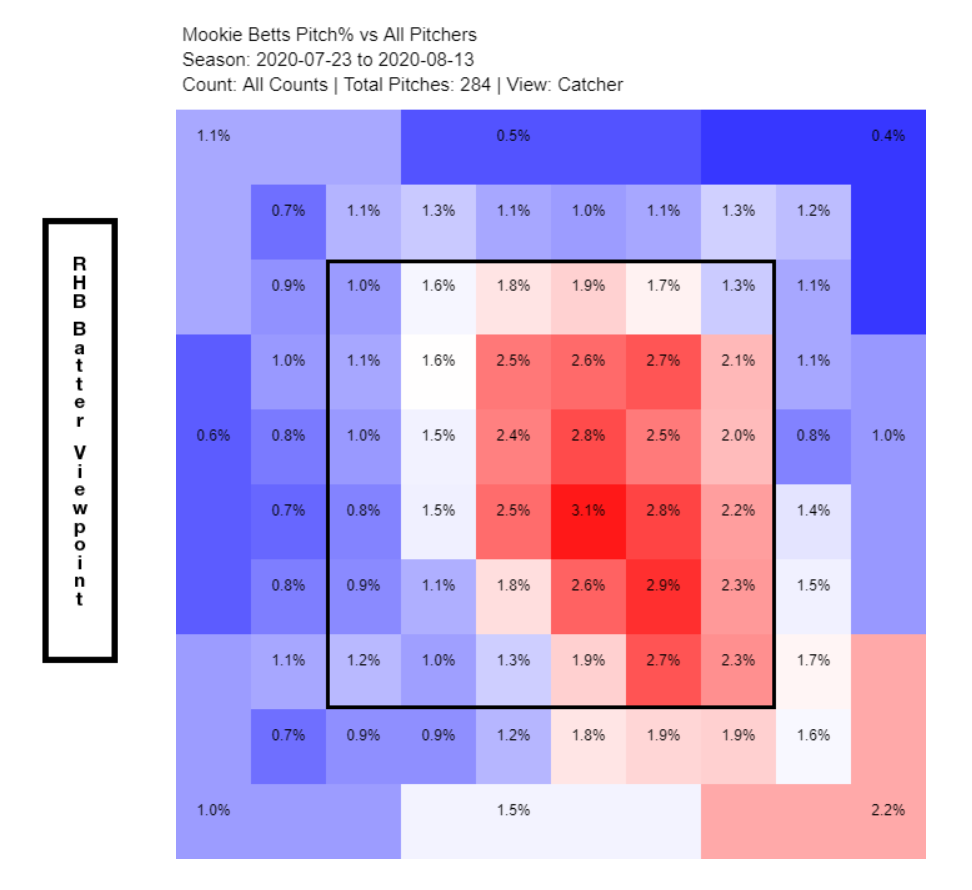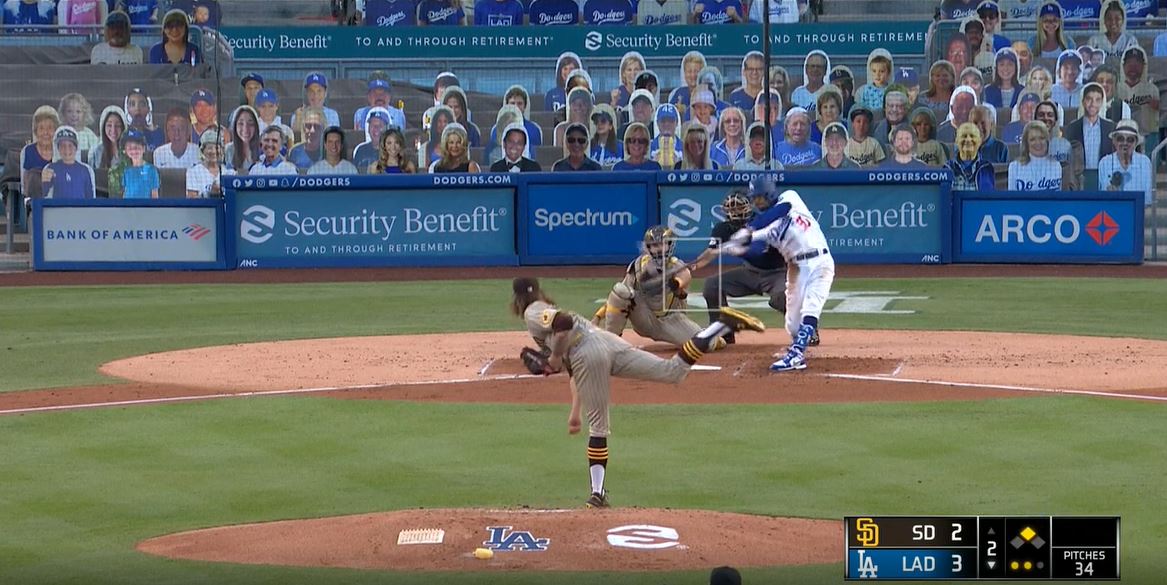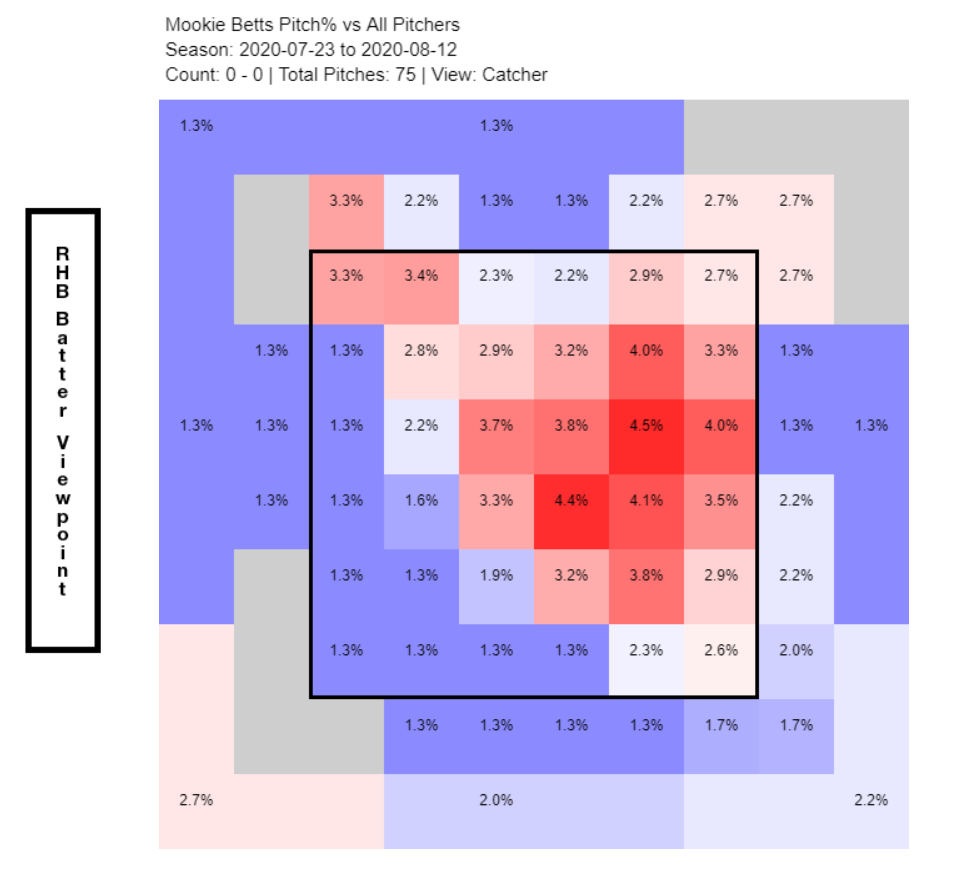Mookie Betts Hit a Home Run
When I sat down to watch last night’s game between the Dodgers and the Padres, I was ready for some offense. The Padres jammed their lineup with righties against Julio Urías, and while the Dodgers didn’t do anything special on their side to face Chris Paddack, they’re pretty much always terrifying. But I absolutely didn’t expect what happened, an 11-2 rout complete with a three-homer game from Mookie Betts.
The game was an impressive show of force from the Dodgers. Those are almost a foregone conclusion with such a potent lineup, even against Paddack — you can’t keep this group from the occasional offensive eruption. What impressed me most, however, was Betts’ first home run of the day. Take a look:
Mookie would hit a homer on the night he got his Silver Slugger. pic.twitter.com/bdBFAWvApw
— MLB (@MLB) August 14, 2020
Paddack would have been pleased with that pitch if he didn’t know the result. Betts is a judicious first-pitch swinger, so you can’t throw him something uncompetitive and expect to get a strike. At the same time, he’s Mookie Betts; you can’t toss a fastball down Main Street and expect to get out of it alive. Paddack chose an excellent compromise, just off the outside corner but close enough to draw a swing. He might have preferred it a few inches higher, but it was a good idea for a first pitch.
If there’s a safe place to pitch Betts, it’s on the outside corner. As I noted when he signed with the Dodgers, he gets to his prodigious power on the inside part of the plate. A handy way of looking at this is ISO per ball in play by zone. That’s an absolute mouthful of a statistic, but all it means is how many extra bases he gets per time he makes fair contact. A single, an out, and a double? That works out to .333. Two outs and a homer? 1.00 (BIP here might more properly be termed contact, as it includes home runs). Betts’ heat map is unbalanced, to say the least:

If that map is any indication, Paddack picked an excellent location. In fact, on average, pitchers have been picking excellent locations all year:

There’s more of the center of the plate than you’d like to see, but that’s inevitable when grouping all pitches together with smoothing, and you get the general idea: away, away, away. In his entire career before yesterday, Mookie had hit exactly one homer on a fastball off the plate away. It was a similar result, but it came from a completely different situation:
That’s an extremely impressive homer, but the sheer unlikeliness was far lower than last night’s. For one, it came across the plate 5 mph slower. It was also a 3-2 pitch, when Betts needed to be thinking swing. It was a happy accident, a combination of Betts’ ludicrous hand-eye coordination and a defensive two-strike mindset.
Betts has seen 3,042 pitches off the plate away in his career. He’s swung at 481 of them. Last night’s blast was his third extra-base hit out of those swings. He simply doesn’t connect with the ball with power in that region of the plate, even when he deigns to swing.
Only this time, he did. Take a look at him at impact, fully extended to reach the ball:

Compare that to a more “normal” Betts home run. Fortunately, we aren’t short of those to pick from. Here’s his third homer of the night, a meatball of a splitter from Luis Perdomo:

That’s how I picture a Betts home run swing. Perfectly balanced, arms in, exploding through the ball. Leave a pitch middle-middle or middle-in, and you can’t be surprised when it leaves the park. But that Paddack pitch? It’s ridiculous.
At this point, I think I’ve established the fact that this homer is out of character for Betts. That’s unfair to Mookie, though. That home run is out of character for anybody. Home runs on pitches outside of the strike zone are already a rarity. Out of the zone away, on the first pitch of an at-bat? They happen more often than never, but not by much. Since 2008, there have been 25 homers that fit my admittedly exacting criteria: right-handed batter, first pitch fastball, off the plate away.
Why so low? It’s a confluence of factors, all of which are inhospitable to power. First, swing rates are low on 0-0 — not as low as they were 10 years ago, but still far below overall swing rate. Second, swing rates are low on pitches outside of the strike zone, and particularly on fastballs outside of the strike zone. Third, power is low overall on pitches off the plate away; the league has a .062 ISO on balls in play in that region over 2019 and 2020. Limit it to pitches vertically in the strike zone — Paddack left the ball roughly belt high — and the ISO stays exactly the same. It’s simply extremely difficult to connect with power on balls that far away.
There doesn’t need to be any broader meaning to this. Mookie Betts is one of the very best baseball players in the game. He might be one of the best of all time before he’s done. He’s the kind of player who does the impossible often enough that it impresses us less than it should.
If you’re in search of a broader meaning, though, what about this? Betts knows he’s being pitched away, particularly on 0-0. Take a look at the location of all the first pitches he’s seen this year:

There’s an even brighter cluster on the outside of the plate than his overall pitch locations, because pitchers are working hard to start the plate appearance off with a strike that he won’t swing at. They’re almost all fastballs, too: he’s seen 71% fastballs on 0-0 so far this year, higher than the league average of 60% and the 57%-ish rate he sees overall.
Consider this terrifying thought: what if he’s learned how to hit that pitch? It doesn’t need to be something he can do consistently; one home run pays for a lot of taken strikes or whiffs. If he can add the ability to ambush fastballs away to his game — and to be clear, he didn’t have it before this year, as this is only his second home run on a pitch that far outside — where are pitchers supposed to hide? They’ll need to be even finer on 0-0 knowing that he can come and get a casual fastball away, and that will get him in better hitter’s counts, and that will get him more fastballs inside, and so on and so forth.
Most likely, that hasn’t happened. Most likely he decided to swing, saw where the ball was coming in, and just went with it. But there’s a chance that he’s added a new skill, and it’s one that complements his game in a terrifying way — well, terrifying for opposing pitchers, at least. The Dodgers will hang double digits on opponents plenty of times this year; the other two home runs Betts hit, and the company his trio vaulted him into, were last night’s headline. He might not hit such a unique home run again, though.
Ben is a writer at FanGraphs. He can be found on Bluesky @benclemens.

shame on the sox for trading this guy.
Agreed – though not so much for trading him as for failing to even make a realistic effort to re-sign him.
This will eventually be remembered in the same vein as Harry Frazee and Babe Ruth.
I’d say this is a bit of hyperbole, if only because there was so much less news and baseball was so much more ingrained in the mainstream culture in those days. I doubt many outside of Boston will give it very much thought after a few years except in the context of bad deals or poor (in both senses) leadership.